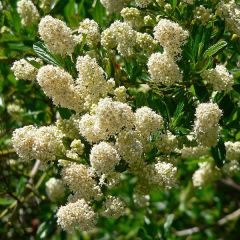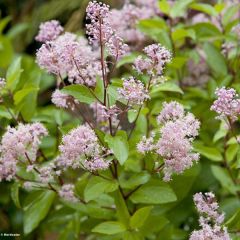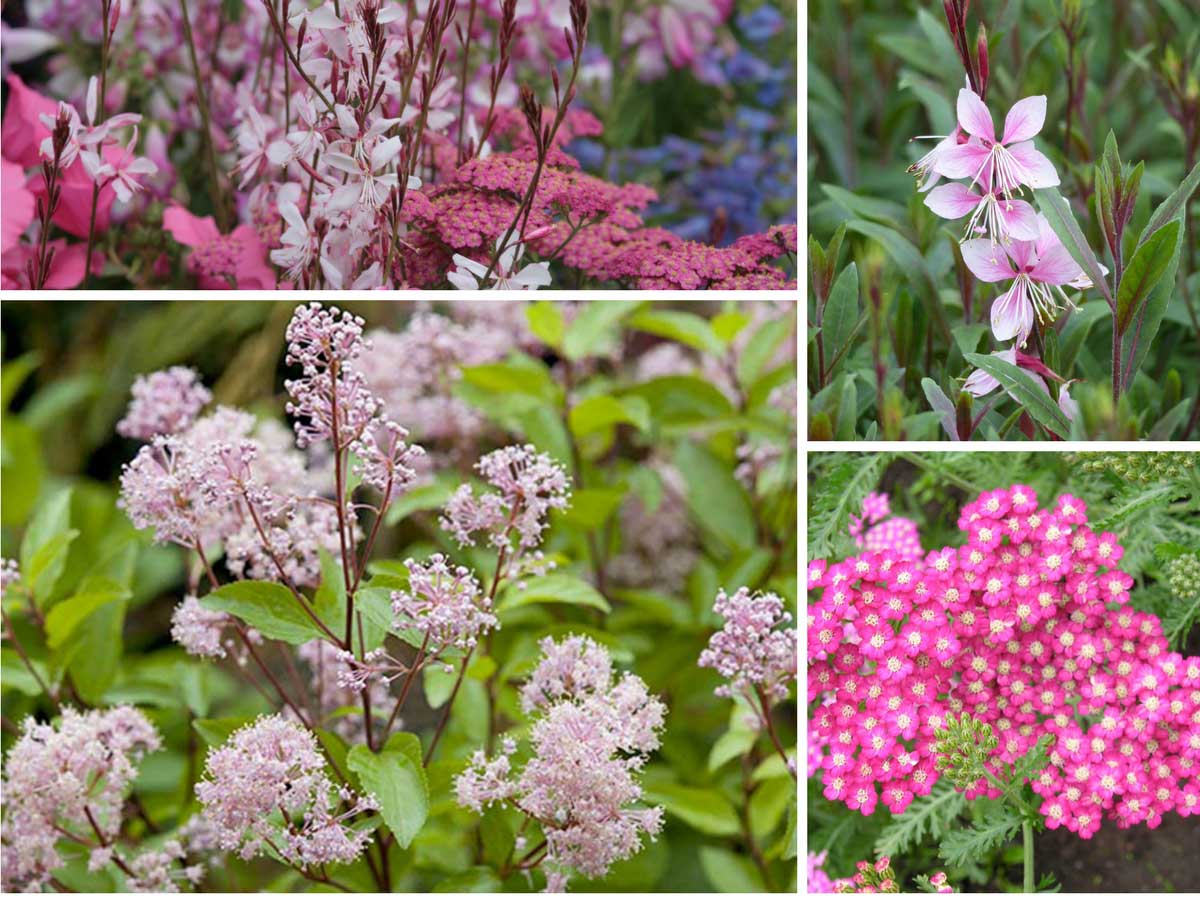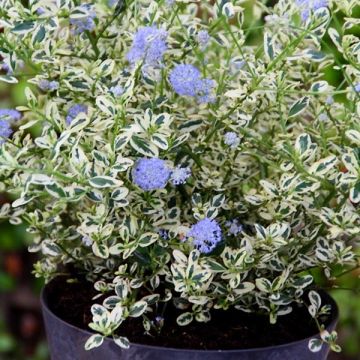
Ceonothus, Californian Lilac: Planting, Care, Pruning
Contents
Ceonothus in a Nutshell
- They produce the most beautiful blue flowers in the garden
- Their spring or summer flowering is spectacular
- Deciduous or evergreen, they are easy to grow as hedges, in borders, pots or as standalone specimens
- They thrive in any ordinary soil provided it is well-drained
- Low-maintenance and undemanding, they withstand atmospheric pollution
Our expert's word
Ceanothus or Californian Lilacs, sometimes called “California Lilacs” for their delicate fragrance and flower spikes reminiscent of true lilacs, are much-loved shrubs prized for their abundant spring or summer flowering, both honey-scented and fragrant. They display their blooms in infinite shades of blue.
From intense blue Ceanothus (sometimes pink or white), creeping, rounded or upright varieties, to hardy evergreen or deciduous types, Californian Lilacs offer an incredible variety of forms. Whether it’s the creeping Ceanothus thyrsiflorus ‘Repens’, the evergreen ‘Skylark’ or the deciduous ‘Gloire de Versailles’ – all are worth growing for their outstanding ornamental qualities in spring or summer.
With good disease resistance and reasonable hardiness (down to -15°C depending on the species), especially in well-drained, light, not too chalky soil and in full sun or partial shade, they thrive in all gardens: as specimens or grouped in informal hedges with other shrubs, in romantic containers or sunny rockeries.
Their versatile nature and pollution resistance make them essential in all naturalistic gardens as well as urban settings.
Compact in size, they form attractive, naturally dense shapes covered with flower clusters.
These generous shrubs, truly very easy to grow, deserve a prime spot in your garden or on your terrace. Planting, care, pruning – here are all our tips for successful Ceanothus and a beautiful flowering season.
Botany
Botanical data
- Latin name Ceanothus
- Family Rhamnacées
- Common name Céanothe, Lilas de Californie
- Flowering D'avril à juillet
- Height 0,45 à 10 m
- Exposure Soleil, mi-ombre
- Soil type Neutre, acide, bien drainé
- Hardiness -10°C-15°C selon les variétés
The Ceanothus, also known as California Lilac, belong to the Rhamnaceae family. They comprise around 55 species of deciduous or evergreen shrubs or small trees, native to North America, particularly the coasts and chaparral of California, as well as Mexico. There are nearly a hundred hybrids widely cultivated in our gardens. The most well-known cultivar is the Ceanothus coeruleus ‘Gloire de Versailles’. Ceanothus adapt perfectly to our climates.
Within this large family, we distinguish: evergreen ceanothus that graciously retain their foliage in winter, and deciduous species also called summer ceanothus.
Evergreen Ceanothus that flower in spring from March-April to June prefer regions with mild winters and rather maritime climates. While they withstand atmospheric pollution and drought well, they are more sensitive to cold and may freeze in regions with cold, wet winters. They are less hardy (withstanding down to -7/-10°C once well established) than deciduous Ceanothus like the Ceanothus ‘Henri Desfossé’ which grow throughout France, flower all summer and are much more cold-resistant (down to -15°C). The foliage may nevertheless sometimes be slightly damaged below -5°C. In mild climates, these species are semi-evergreen.

Ceanothus ‘Gloire de Versailles’ – Photo: Patricia Mario
They take on very varied forms depending on the species, ranging from small trees to subshrubs. Their size varies by species from 50 cm for creeping species like Ceanothus prostratus to 8-10 m in height for the tallest ceanothus such as C. arboreus which can become proper trees. Most remain quite compact, not exceeding about 4 metres in height and spread.
Ceanothus naturally form a bush composed of multiple stems. The branching is substantial, but consists of small branches each bearing numerous leaves, giving them a dense habit. The bushy, flexible form is more or less compact or spreading, arched, upright or prostrate in groundcover species.
Their growth is moderate to fast in not too poor soil: they can reach mature size in five or six years and grow 30 cm per year. Creeping varieties grow quickly, covering slopes and rockeries in just a few years. Fast-growing evergreen Ceanothus have a rather short lifespan of about fifteen to twenty years.
Whether deciduous or evergreen, ceanothus are particularly floriferous shrubs offering all shades of blue, from pale to indigo. In evergreen Ceanothus, flowering is very abundant. It begins in March-April, later in cold springs (except for Ceanothus ‘Burkwoodii’ which flowers in summer) and lasts about three weeks. Some evergreen varieties offer repeat flowering.
Summer Ceanothus provide less spectacular but longer-lasting blooms. The flowers appear in successive waves throughout summer from August to October.
In spring or summer depending on the species, flowers gathered in panicles or upright clusters 3 to 12 cm long emerge at the ends or along one-year-old branches and cover the entire plant with dense, fragrant blue clusters – sky blue, indigo blue, dark blue, navy blue, bright blue, more rarely pale pink or creamy white. They appear as flower buds, tightly packed together. They gradually open into very small tubular flowers, eventually forming beautiful pyramidal inflorescences (or thyrses) so numerous they almost obscure the foliage. While their fragrance isn’t powerful, it is subtle and reminiscent of lilac, earning Ceanothus the nickname ‘California Lilac’. Some evergreen varieties are very attractive to bees and have a honey-like scent that draws bees and butterflies. This fragrant flowering is followed by seed formation which are expelled to the ground when mature.
California Lilacs are beautiful, bushy and vigorous shrubs. With relatively fast growth, they present quite lush vegetation. Compact flower spikes overwhelm handsome, finely textured glossy green foliage. They bear deciduous or evergreen leaves, alternate or opposite, finely toothed, sometimes with strongly marked veins, oval, elliptic or oblong, generally shiny on top and downy beneath. Ranging from 1 to 10 cm long, they appear in shades from medium green to dark green, including olive green, grey-green or blue-green with a satin finish. Some like Ceanothus arboreus ‘Trewithen Blue’ can bear leaves up to 10 cm long. The evergreen foliage of ceanothus withstands atmospheric pollution.
Ceanothus are easy to grow in ordinary but well-drained soil. However, they don’t all have the same requirements. Evergreen types prefer rather maritime climates and regions with mild winters. They fear neither heat nor drought. All ceanothus thrive in well-drained, sufficiently rich, light soil that’s not too chalky. They tolerate slight acidity and chalk but in small amounts. They make do with ordinary even poor soil, fresh to very dry in summer. They dislike heavy, waterlogged soils and winter/ summer moisture which can prove fatal. Give them a warm spot, sheltered from cold draughts, against a sunny wall for more frost-tender evergreens. They only flower well in full sun but tolerate partial shade, especially in southern France. Deciduous Ceanothus are more cold-resistant (down to -15°C) than evergreen species (-7/-10°C), especially in well-drained soil.
Ceanothus are versatile in the garden. They can be used in shrub borders or as specimens, in borders, informal hedges or trained against walls. Creeping varieties are perfect for rockeries, low hedges or groundcover on large slopes. Deciduous species, being hardier, thrive equally in open situations or against walls. Evergreens do well in coastal or Mediterranean gardens, right by the sea. Some varieties are suitable for container growing on balconies and terraces. They combine well with plants that will accompany or follow their flowering, like Fremontodendron californicum, shrubby cistus, brooms, junipers, laburnums, Chinese Almond, flowering quinces or Syringa, with clusters of small blue or pink flowers that should bloom simultaneously.
Use them mixed into large flowering hedges alongside repeat-flowering bush roses, hydrangeas, deutzias, serviceberries or buddleias.
Species and main varieties
The Ceanothus genus includes over 50 species as well as around a hundred hybrids and cultivars that are easier to acclimatise, less frost-sensitive and more compact compared to wild species. The foliage can be evergreen or deciduous. Evergreen Ceanothus are less hardy, preferring mild and humid climates, and flower in spring. Deciduous species, which are hardier, bloom throughout summer.
The choice is therefore very wide; the Ceanothus ‘Gloire de Versailles’ is the hardiest of the deciduous species, ‘Concha’ is a beautiful compact variety with one of the most striking blue flowers, while Ceanothus pallidus ‘Marie Simon’ produces pink flowers in late summer, and ‘Italian Skies’ forms a neat, small dome covered in delicate foliage.
Ceanothus exhibit a wide variety of forms depending on the species. Some are prostrate and won’t exceed 1m in height at maturity, while others, like Ceanothus arboreus, have an upright habit and are notable for their impressive size (4 to 8m tall).

Ceanothus display a great diversity of growth habits
Compact varieties like the Ceanothus thyrsiflorus repens, which cascade gracefully, work wonderfully as ground cover, in containers, and thrive on dry slopes.
Choosing a Ceanothus can be guided by size (tall or spreading), flower colour, or blooming period (early or summer-flowering). Discover our favourite Ceanothus for borders, beds, containers, hedges, rockeries, or ground cover.

Ceanothus arboreus Concha
- Flowering time May, June
- Height at maturity 3 m

Ceanothus thyrsiflorus repens - Californian Lilac
- Flowering time June, July
- Height at maturity 1 m

Ceanothus foliosus Italian Skies
- Flowering time May, June
- Height at maturity 1 m

Ceanothus griseus var. horizontalis Yankee Point
- Flowering time May to July
- Height at maturity 1 m

Ceanothus thyrsiflorus Millerton Point
- Flowering time June to August
- Height at maturity 2 m

Ceanothus delilianus Gloire de Versailles
- Flowering time August to October
- Height at maturity 1,50 m

Ceanothus delilianus Henri Desfossé
- Flowering time September to November
- Height at maturity 1,50 m

Ceanothus pallidus Marie-rose
- Flowering time July to November
- Height at maturity 1,50 m
Discover other Ceanothus
Planting Ceanothus
Where to plant
Trained against a wall, in flower beds, as ground cover or as standalone specimens, ceanothus are versatile plants. Compact, spreading varieties of evergreen ceanothus work well as ground cover, in containers or for covering sunny slopes or pergolas.
- Ideal exposure: Give them a spot in full sun or partial shade to maximise flowering.
- Sheltered position: California lilacs appreciate sheltered positions protected from cold. Evergreen ceanothus are more tender and less frost-hardy than deciduous species, and may struggle with severe winter frosts in northern France. In these regions, choose a location sheltered from cold winds. Train the most tender evergreen varieties against a warm wall.
- Suitable soil: They adapt to most soil types but prefer light, neutral soils provided they are well-drained. Once established, ceanothus can tolerate summer drought. They thrive even in poor, very dry summer soils. They’re easy to grow in free-draining soil where they’ll show greater hardiness as they dislike excess moisture, heavy or waterlogged ground. When planted in ideal conditions, evergreens can withstand brief frosts down to -12°C. They tolerate all soil types except very chalky soils where they may suffer from chlorosis, causing leaf discolouration and yellowing.
When to plant
Spring is the best time to plant ceanothus. Plant in March-April, at the latest in May, when all risk of frost has passed. Autumn planting from September to October is also possible for deciduous species, particularly in mild regions with temperate winters.
How to plant
Mix deciduous and evergreen species to stagger flowering from spring through late summer. Space plants 2m to 4m apart depending on the ceanothus variety. In moisture-retentive winter soils, it’s best to plant ceanothus on a mound as their roots can’t tolerate waterlogging.
In open ground
- Soak the rootball in a bucket of water before planting
- Dig a hole about 40cm deep, loosen the soil and remove stones and roots
- Create a 30cm deep layer of clay pebbles or gravel then spread a layer of well-rotted compost in the base
- Place the rootball in the hole with the crown level with the soil surface and backfill with a mix of garden soil and good quality compost
- Firm around the base, create a watering basin and water thoroughly
- Water weekly in dry weather to aid establishment; thereafter watering is unnecessary and may even be detrimental.
Trained against a wall
- Tie in shoots as they grow
- Encourage lateral branches by removing others
How to plant ceanothus in pots?
Smaller ceanothus varieties make stunning container plants for patios, and can be moved under cover in very cold regions.
- Choose compact varieties (‘Italian skies’, Ceanothus thyrsiflorus repens)
- Select a container large enough for proper root development (minimum 65cm height)
- Ensure perfect drainage with a layer of clay pebbles or pumice in the base
- Plant in a mix of sandy soil and good quality compost
- Choose a sunny or partially shaded spot in southern regions, well sheltered from cold winds that may scorch foliage
- Water regularly – twice weekly in summer, sparingly in winter
- Repot every two years into a larger container
→ Learn more in our guide: Growing Ceanothus in pots
How to Prune a Ceanothus and Care for It Properly
Hardy down to -15°C depending on the species, drought-resistant as well as tolerant to air pollution, Ceanothus are exceptionally robust. They require no specific maintenance and are perfect companions for gardens without gardeners!
Except during the first two summers after planting, it is unnecessary and even discouraged to water Ceanothus planted in the ground. Simply add compost to encourage growth.
Potted specimens, however, require more attention than their in-ground counterparts: liquid rose fertiliser added to the watering can to promote flowering and regular watering, especially in summer.
Ceanothus do not require special pruning—simply remove dead or unbalanced branches after flowering. During summer, deadhead spent blooms on summer-flowering varieties (a hedge trimmer can be used) to encourage a second flush in autumn. A very light trim is enough to remove faded flower clusters. If you wish to reduce the size, maintain a compact shape, or reshape the plant, prune after flowering for evergreen Ceanothus and in March for deciduous varieties.
Every 3 to 4 years, if cold weather has damaged your shrub, you can carry out a harder prune in late winter or early April, cutting back branches by a third to remove dead wood and maintain a compact shape. In this case, it will not flower the same year.
In case of frost, foliage may brown but usually regrows in spring. Protect your Ceanothus, especially evergreen species, with winter fleece during severe frosts. > Also read our tutorial guide: Protecting Ceanothus in Winter
Pests and potential diseases
Ceanothus are exceptionally hardy flowering shrubs that, when properly established, face no significant threats – except for defoliating caterpillars in spring. These voracious eaters can strip the foliage bare. If attacked, the simplest solution is to act at the first sign of caterpillars by cutting off and burning affected branches.
In waterlogged soil, Ceanothus are highly susceptible to fungal diseases like root rot (Armillaria). In poorly drained conditions, the roots rot away, leading to the shrub’s decline or even death – the bark peels off, revealing white fungal growth. As no effective treatment exists, ensure perfect drainage at planting time; in heavy soil, plant your Ceanothus on a slight mound.
In highly alkaline soil, they often suffer from chlorosis, causing leaves to fade and yellow.
→ Learn more about Ceanothus diseases and pests
Propagation: Ceanothus Cuttings
Ceanothus are quite easy to propagate from cuttings. Between August and September, take 15 cm semi-ripe cuttings.
- Remove the lower leaves, keeping only two pairs of upper leaves
- Cut them in half
- Plant them in a light mix of compost and peat
- Place under a cold frame or cloche in shade and protect from frost in winter
- Keep the growing medium moist until rooting occurs, which takes 1 to 3 months
- Plant your cuttings in the ground after one or two years of growing in pots
Pair it with in the garden
California Lilacs thrive in various garden settings, at the back of perennial borders, grouped in informal hedges, in romantic containers placed on terraces or balconies, or even trained against a wall to adorn a fence. The creeping varieties are ideal for rockeries or as ground cover.
Evergreen California Lilacs provide year-round structure with their dense green foliage. All varieties enchant with their sky-blue, pink or white fragrant blooms. Compact and pollution-resistant, they make excellent shrubs for urban gardens. They’ll add a touch of freshness and cheer to neglected corners of your garden.
In sunny borders or on slopes, they combine beautifully with various shrubs of different tones and forms for striking effects.
They pair wonderfully in flowering hedges with Buddleias, Weigelas, Witch Hazels, Hibiscus, Viburnums, Lavateras and create magnificent backdrops for bushy roses.

California Lilacs pair beautifully with roses – left: Iceberg or Fée des Neige rose and Ceanothus Skylark – top right, Ceanothus impressus Victoria
California Lilacs combine perfectly with Mock Orange or Mexican Orange Blossom (Choisya ternata ‘Sundance’).
Yellow-flowering plants that bloom simultaneously with California Lilacs create stunning contrasts with their profusion of large blue flowers (C. ‘Concha’). They offer beautiful complementarity especially with shrubs like Brooms, Golden Chains (Laburnum anagyroides) and early-flowering yellow perennials such as Euphorbias, Primroses, and German Iris.
Against a wall, they work wonders with Scorpion Vetch or Coronilla valentina Glauca, in a yellow, blue and white border for example, alongside blue creeping rosemary, creeping California Lilac, Caryopteris, Perovskia, Convolvulus cneorum…
On large slopes, they’ll neighbour beautifully with ornamental grasses like Fountain Grass whose soft habit and airy inflorescences contrast wonderfully with the dense foliage and bushy silhouette of California Lilacs.
In containers, pair them with small early-flowering blue or yellow bulbs like Narcissi, Muscari, Scilla or species Tulips alongside dwarf conifers. Combine them with Rosemary, Lavender or Hibiscus.
They’re particularly striking amid silver, golden or glaucous foliage; Artemisia, Lavender.
The powdery blue, pale pink or white flowers of California Lilacs will unfold in delicate clouds beside the compact inflorescences and handsome foliage of Hydrangeas. The Ceanothus pallidus Marie Rose® pairs beautifully with Yarrows or Gauras.

A lovely rose combination with Ceanothus Marie Rose® (bottom left), Gaura Cherry Brandy and Achillea millefolium Cerise Queen
Useful resources
- The most beautiful deciduous or evergreen Ceanothus can be found on our website
- Do you love blue-flowering shrubs? Discover our article: 8 blue-flowering shrubs you must have in your garden
- Explore our advice: When and how to prune a Ceanothus?, Which Ceanothus to plant in your region?; Blue Ceanothus: the most beautiful varieties
- Learn more about diseases and pests affecting Ceanothus
- Our advice sheets: Growing Ceanothus in pots and 5 Ceanothus varieties to grow in pots
- Our advice sheets: Evergreen Ceanothus: the best varieties; Ceanothus: the hardiest varieties; Protecting Ceanothus in winter; 6 Ceanothus with decorative foliage
- Our tutorial: Propagating Ceanothus from cuttings
Frequently asked questions
-
My Ceanothus is turning yellow, why?
It's likely a soil composition issue. Summer-flowering Ceanothus prefer only very small amounts of lime. In overly calcareous soil, they frequently suffer from chlorosis: their leaves discolour, turn yellow, then fall off. Apply organic matter (well-rotted manure, compost...) annually.
- Subscribe!
- Contents



















































Comments